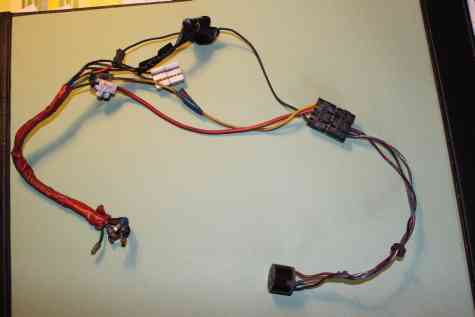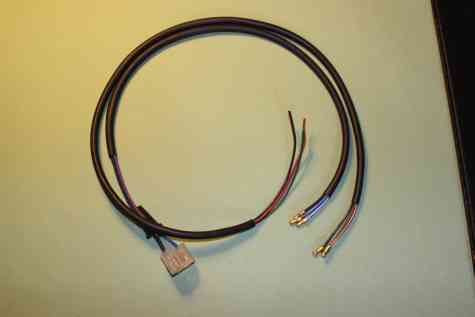N_Reparaties - N_Repairs (20.07.2010 )
Probleem: N Electrical Equipment Wiring from loom (frame) to front lights
Shows one can't keep on repairing the repairs.


Geoff provided me with the wiring from loom till front lights - in the correct colour.
As I hadn't dismantled the lights before ordering the wires, Geoff put the three-pin connector on the one for the headlights and didn't put connectors on the wires for the parking-flash-lights (I presumed they were soldered). Shows that for my Sabra (ST 4878) he could have put bullit connectors on both sides of every wire, but that should be checked for every individual car. Best length of both wires is some 80cm.
Jef Neefs
Probleem: N Electrical Equipment Wiper motor not Parking
Thanks Jacques
Probleem: N Electrical Equipment Benzinemeter-Thermometer
Al een hele tijd problemen met de indicaties van de thermometer en de benzinemeter. Nu moet je bij alle auto's leren "Hoe leeg is leeg? en Hoe heet is heet? voor de thermometer maar bij de Sabra moest je je dan ook nog herinneren hoevele toeren de motor draaide de laatste minuten en hoeveel electriciteitsverbruikers óp stonden de laatste minuten.
Geleerd (zie electrisch schema pagina N13); er is een afzonderlijke voltage regulator voor de waterthermometer en de benzinemeter. Dat ding was dus duidelijk stuk. Binnengegeven bij een garagist die voor een nieuw zou zorgen... de man slaagde er in het origineel te verliezen...
De
Voltage regulator heeft als bedoeling deze twee circuits op een lagere spanning
te laten werken (10V)...daardoor wordt de aanduiding van de twee meters
onafhankelijk(er) van de spanning op het electrisch systeem... 13,5V wanneer de
dynamo bijlaadt...11,5V als de dynamo niet bijlaadt en er toch stroom moet
geleverd worden door de batterij.
De Voltage regulator is standaard eigenlijk een bimetaal gestuurd apparaat dat
bij hogere stroomsterkte (-spanning) eventjes uitschakelt en dan terug
aanschakelt. Als je met een klassieke voltmeter de outputspanning meet dan
gaat de naald permanent van 2V naar 11V. Verhoog je de spanning van de
batterij (batterij-lader) dan gaat de naald van de Voltmeter heviger op en neer.
De naalden van de thermometer en benzinemeter bewegen te traag om deze snelle
spanningswisselingen te volgen en stellen zich in op een gemiddelde waarde,
bepaald door de stand van de benzinevlotter en de gemiddelde spanning over hun
systeem (iets lager dus dan de 12V).
Oplossing... niet 100% maar stukken beter:
De
originele voltage-regulator zit onder het dashbord achter de thermometer
bovenaan tegen de verstevigingsrib geschroefd.
Heeft buiten een massa-verbinding, vier contactjes...(twee aan twee aan elkaar
verbonden), twee donkergroene leveren spanning, twee lichter-groene gaan naar de
meters, stroom loopt door de meters naar de "sensoren-zenders" en naar
de massa.
Years I've been having problems with them.
See electrical scheme: these two gauges have a separate Voltage regulator because if they would get the normal working voltage they would indicate different values with idelling engine (12V) or engine running at higher RPM's (14,xxV).
This Voltage regulator didn't work properly on my Sabra. I really found out recently. Although it was obvious that engine speed influenced the gauges severely.
When
the temperature gauge was getting higher than I liked, I allways did like
everybody: switch on the heater fan to provide extra cooling.
It allways made the temperature drop by +/-5 degrees. Now long ago the
heater valve didn't shut off properly so I was always getting heated air in from
the heater system but after the valve was fixed with the heater valve closed I
got cold air inside the cabine - fine.
But
then I noticed that when I put on the heater fan ! even when the heater valve
was closed ! temperature gauge dropped 5°C.
So it dropped because voltage had dropped, not because I provided extra cooling.
So
I bought a new?? Voltage regulator, didn't cure the problem.
So I swapped to the above mentioned system, was working better but
trimming was difficult, this thing was not devellopped for cars, I reckon I had
to use a fixed resistor and in series with it a much smaller adjustible
resistor, the fixed taking care of 9V and the adjustible resistor taking care of
whatever between 9-11V.
Anyway: bought a new Voltage regulator with Carwise. Readings where independent of the engine RPM now, but much too low: i.e.just after refuelling the gauge showed half-full (half empty for pessimists) and temperature never rose beyond 70°C though my themostate only opens at 82°C. My last otter switch switches on at 92° and it was ON several times when the gauge showed 70°C
Then I noticed that the Voltage regulator has an adjusting screw on it. The regulator works with a bimetal so when starting the gauges go too high (bimetal has to warm up) but now (having turned the regulator-screw one turn to the right) temperature reads constant 78 in normal driving conditions and fuel is over 3/4 when full. So I guess turning right a little further would get the temperature to a guessed 85° and fuel tank to full when full.
Will have to find-out where on the fuel-gauge is "empty" (guess it will be sllightly above 0) but temperature is more important.
The Voltage-regulator works in a long-time-ago-way by switching off tension when the bimetal is warm enough and switching on after the bimetal has cooled so it must be influenced by the ambient temperature and by total current consumption (full fuel tank will give lower temperatures) but quite precise will be good enough for a Sabra I guess). The gauges are too slow to follow the rather fast voltage switching (recent digital Voltage meters have also problems... they show 4V or 10V. On older analogue meters you see the voltage needle go up to over 12 and drop to zero.

N8 Ignition
Ignition coil:
When
putting my Sabra back on the road in 2000; though the engine ran (in my garage)
normally I decided to replace all of the ignition system, just in case. So
replaced sparking plugs, wires, contactpoints, condensator, coil. What I
didn't know is that coils had changed over the years: nowadays coils expect 9V
under normal working conditions, the Sabras original coil expected (and got) 12V
(and in the shop I just asked for "a coil").
The new coil got 3Volts more than it expected and eventually got warm and
stopped working - untill it had cooled down.
At the beginning I could drive for an hour without problems but after a while
(the heating didn't do no good to the coil) it broke down after a shorter period
of driving - certainly in hot weather and at high speed.
As I doubted the fuel tanks, fuel lead, fuel pump, fuel filter, floaters, carburettors I used to carry a pump to blow bike-tubes and every time the engine stopped I disconnected the fuel leads and blew them through direction carburettors and direction fuel tank. This used to take some 15 minutes and afterwards I could drive again for some time (the 15 minutes were enough for the coil to cool down).
A lended 12V coil made the car run wonderfully and learned me that there's the two (above mentioned) types of coils.
A
12V coil worked fine, as did the 9V with a "ballast"-resitance in
series with it.
Later I switched to the 9V coil thinking it was an improvement against the 12V
because it would consume less power from the dynamo.
As there's no lead to control the ballast-relay on the starter engine I added a
relay that shortcuts the resistor when the starter engine gets power.
So while starting the coil gets 12V, once the engine runs the coil gets its
proper 9V. As the starter solenoid is close to battery and coil this
wasn't a great job to do.
N8 Ignition (Electronic)
Not that I had problems with my ignition anymore but a friend advised me to buy the pertronics electronic ignition. He advised me to take Ignitor II as Ignitor I can't stand it if you forget to switch off ignition. On a fair I learned that the pertronics II wasn't made for Sabra-like distributors and would never be made by lack of space in positive earth cars. So I was persuaded to buy an Ignitor I type LU-142AP12.
The car drove properly, with the new ignition mounted as it came.
I notice no difference except for the fact that I won't ever have to replace my contact-points again.
Replacing contact-points and condensator with the ignitor was simple and straightforward. Only problem is that in the Sabra-handbook the description of the timing-trimming is based on the opening of the contact-points. To be certain the timing is correct you need a stroboscope with the ignitor, but that's a once-and-never-again-procedure. I lended a stroboscope and put the advantage to +/- 7°.
N8
Ignition (Electronic)
Ook de electronische ontsteking gemonteerd en
deze doet het zeer goed. Ik heb wel ook een andere bobijn geplaatst (hoger
rendement en heb nu grotere vonken op de bougies)
Het merk is Multic Magnetic en van Franse
makelij. Werkt met een draaiend schijfje met vier magneetjes. De extra regeling
van de voorontsteking via het membraantje is niet meer aangesloten en het werkt
prima. De fabrikant is Delmotte 28 Hauts Champs (BP 12) 62137 Coulogne Frankrijk
tel 0033 321 979 895 fax 0033 321 963 703
www.del.Opi.com Kan misschien
interessant zijn om op de site te zette
De kit is kompleet, zelfs ontstoord voor de radio en electronisch beveiligd
N Wiring diagram colours
Need exell to open it. Thanks Geoff
N Distributor - cleaning up
Mail of bel mij als je tips, hints of kennis op dit gebied hebt... 03/236.00.84